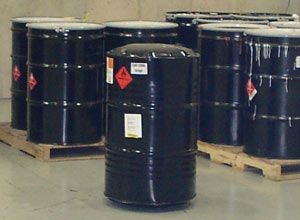 Photo Doug Rohn Crews were confronted by this bulging drum at the scene. |
Hazmat crews do well sometimes to observe hazardous materials events from a distance. Confined chemical reactions, potential BLEVE incidents or even situations where fire erupts can all result at these incidents.
This stance was taken in Madison, Wis., in June when an engine company was called to the scene of a 55-gallon steel drum that was beginning to bulge. The drum was in a contained room at a paint and coatings manufacturing facility. Inside the room — which had its own exhaust system that exited through a chemical scrubber prior to being discharged to the atmosphere — were other drums of finished product.
Prior to the arrival of the engine company, the building was evacuated as a precaution. The company suspected that a small amount of water had been added to a glue varnish used as a coating, causing a chemical reaction within the drum. Plant personnel indicated to the engine company that at 150 F, the product would begin to polymerize but should stabilize itself below that temperature based on their prior experience.
The three products known to be in the drum were:
- ADCOTE - A clear liquid that has a reaction to water (classified by DOT as paint)
- FAST CSR LACQUER – Mostly ethanol used to dilute the ADCOTE
- COREACTANT - A polymeric isocyanate used as a solvent (COREACTANT is water reactive and will polymerize in contact with water)
The 55-gallon steel drum was a closed-top drum that was sealed with both bung plugs intact.
Prior to the arrival of the engine company, the drum had expanded but did not rupture. The temperature of the drum reached 159 F according to readings taken from a thermal imaging camera used by the engine company used. As a result, the engine company officer called for the hazardous incident team (HIT) to respond to the scene for additional assistance.
As soon as HIT personnel were on scene and received a situation assessment, they were escorted to the room where the drum was located. The monitoring instruments that were utilized — including a quad-gas monitor —showed no readings, while only 3 ppm was recorded on the photoionization detector (PID), most likely the normal background for this industrial complex. HIT personnel observed the drum from a distance of about 15 feet and found that it had begun to cool to 144 F. Fifteen minutes later, the drum had cooled to 141 F.
After conferring with plant personnel, it was decided that facility personnel could be allowed back into the building, but the room with the drum would remain isolated until it reached room temperature. All responding fire department units were released at that time.
It was also decided that the original responding engine company would monitor the drum approximately every two hours until the drum reached room temperature. About six hours later, it had dropped to 120 F. After consultation with plant personnel, it was decided to remove the bungs and overpack the bulging drum when it assumed room temperature.
The situation was handled right and no one was injured. The engine company correctly secured the area and promptly called for the expertise of the hazmat team but also took thermal readings with a tool that was available to them. They did this all at a distance and with little to no risk. They also met with and conveyed vital information, such as facility material safety data sheets (MSDS), with the hazmat team personnel.
HIT personnel also monitored the atmosphere within the exclusion area and found nothing to cause alarm. They also used a heat gun to check for the temperature of the drum. It was soon found that the reaction within the drum was over and the temperature was dropping. The reaction was from polymerization, an exothermic chemical reaction, where a solid polymer is formed. In a closed container, the heat and pressure may cause a rupture and that was what caused the drum to bulge, as can been seen in the photo at the top of this article.
In the world of hazmat response, it is prudent to determine at the earliest stages what stance to take. Strategies should include both offensive and defensive postures, but you should also consider taking no action in the right situations. Sometimes there is nothing better to do until the reaction ceases.
The author wishes to thank Lt. Doug Rohn for assistance in the writing of this article.

